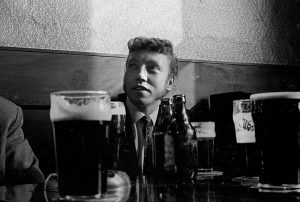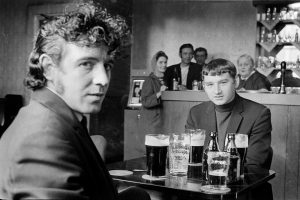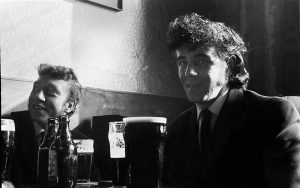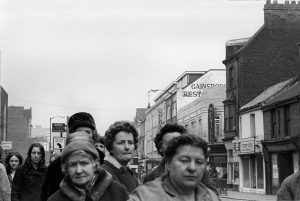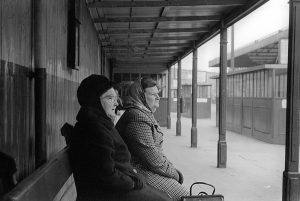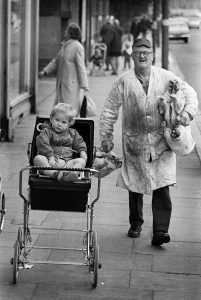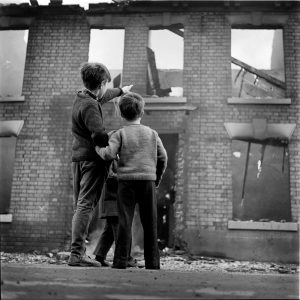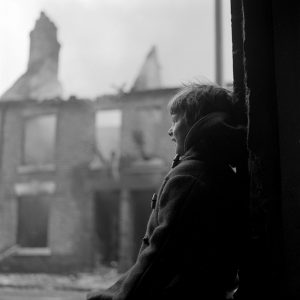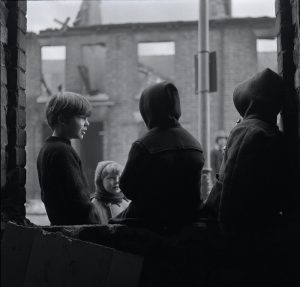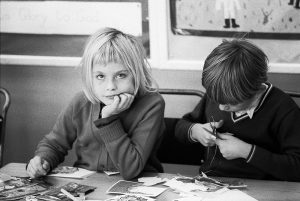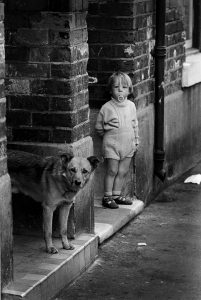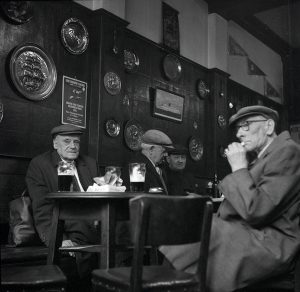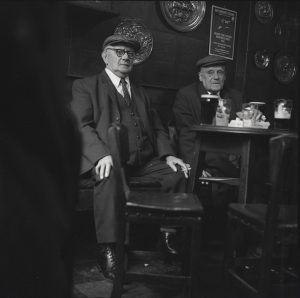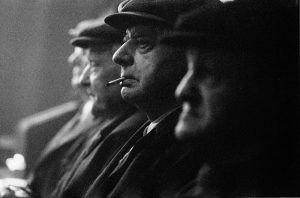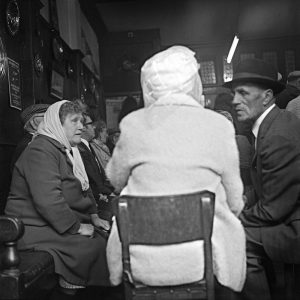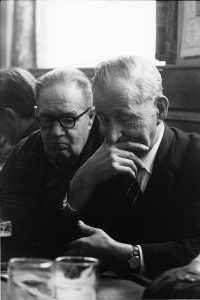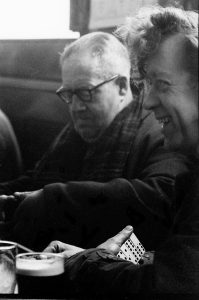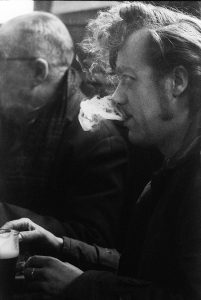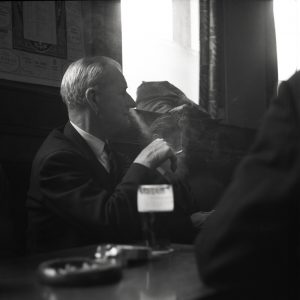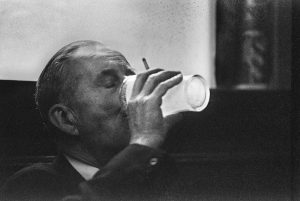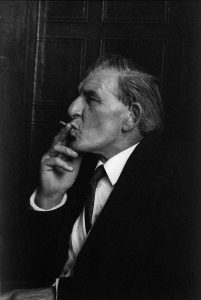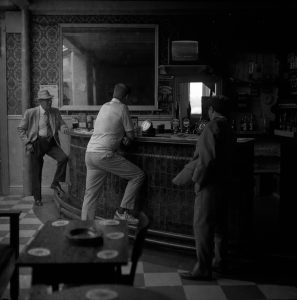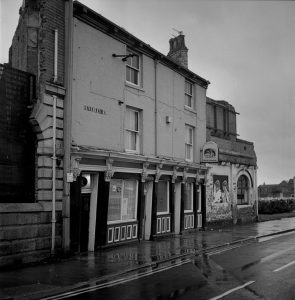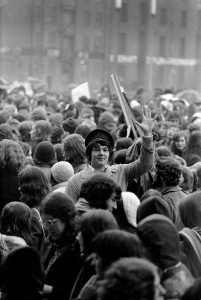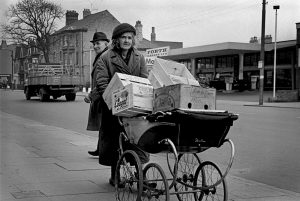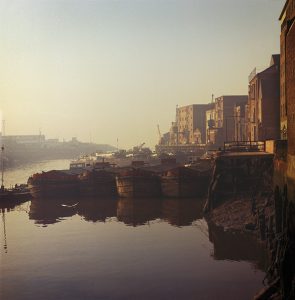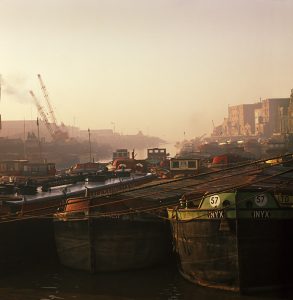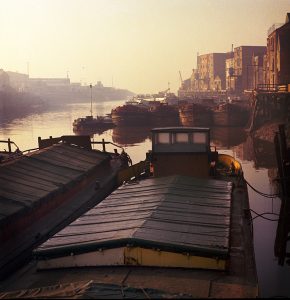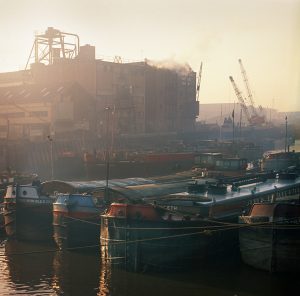
Click on image to start Lightbox
Women of Hull
Andy Warhol said you can’t take a bad picture of the human face, and he’s right – thank goodness – since as a novice photographer I still hadn’t got to grips with focus controls. What does it tell us this huddle of women covering the generations?
Well they don’t look like they have any pretentions for a start, they seem intent with just getting on with things.
In a tough town the women were often tougher than the men, they held everything together. Men might swagger and rail against their lot, women simply got on and made the best of it.
One of our neighbours, was a young German bride when her husband a British Tommy brought her over to Hull straight after the war. She lived for a while down Hessle Road. Since Hull was one of the most heavily bombed cities in the country, I asked her how she got on with her neighbours, how did people down Hessle Road treat her. She didn’t have any complaints, she said, “they were rough… but friendly.”
‘Pals’ Trawlermen
The Anchor Pub Hessle Road
I think they were a bit embarrassed at being photographed in a way that seems unimaginable now. Today everyone photographs everyone else and then they photograph themselves.
I don’t think they could understand why I wanted to take pictures of them, why I found them interesting?
Years later I was out drinking with a two older trawlermen, one of them was the dad of a friend of mine. He was a big tough man with a sense of humour, and could start fights in far flung bars just out of sheer boredom to see what would happen. He was going back to sea at some ghastly hour early the following morning, I asked him how he felt about that, he said, “It’s funny, but even after all these years I still feel frightened.”
That’s why these men are interesting, but I wouldn’t know it at the time. All I could see where a couple of lads who could drink a lot.
Three day millionaire
The Anchor Pub Hessle Road
We had to choose ‘Archetypes’ for a college project. I settled on ‘Deckie Learners’. I remember being disappointed that this chap Mick didn’t have the right hairstyle – a greased quiff with the ducks-arse finish.
I wanted him to fit an image I had of what a Deckie Learner should be. They had a reputation for being tough and big drinkers who could cause trouble, so I posed him against the bar and asked him to look mean… but he was holding a half pint, another disappointment.
It’s a dishonest attempt at a portrait.
But Mick transcends all that with his own honesty. A young man in an immaculate suit, out to celebrate his short-lived wealth. Simply pleased to be where he was, young and alive and cash in his pocket.
His immaculate suit with its pleated back and wide waistband, white socks and loafers a jubilant celebration of his tribe.
The Pathologist
The Theatre Tavern
I was told that the older gent at the bar was Hull’s leading police pathologist. Whether that was true or not, I don’t know, but Queen’s Gardens cop shop was just around the corner and his clothing was certainly of a smarter cut than the other customers, so maybe. What strikes me now is the overcoat and the hat. No one wears overcoats in bars these days, and not many people wear hats. When I look at my old contact sheets everyone is sat around in overcoats, headscarfs and hats, which makes me think the pubs can’t have been heated very well. Not that it seemed to matter, most pubs were jam packed with bodies; creating noise, smoke, laughter, warmth and human contact. Maybe that’s what the Pathologist was raising his glass to – life.
Trinity House boys
Taken in the old Paragon Bus Station, one of my first photographs is just an experiment really, testing out a long lens, but Clee liked it. So he printed it up for me.
This was my first realisation that these little strips
of negatives once magnified on to paper could give you interesting compositions and tell intriguing stories. But the biggest surprise of all was the power of black and white photography to transform the world of the everyday.
Man in the street
I don’t know what the handbag signifies, maybe a different sexual orientation, maybe just a place to keep his cigs and money. This was 1973, we had a long way to go regarding women’s rights, gays and racial prejudice – and as for trans gender? I didn’t even know what it meant. Germaine Greer had just published The Female Eunuch, inviting admiration from many, but loathing and derogatory remarks from a voluble hard core. If you were different from the crowd it paid to keep your head down and hope no one much noticed. Then again maybe this chap didn’t give a monkey’s what anyone thought. Hull folk had a long tradition of going their own way.
Man in the Paragon Pub
This was one of my favourite pubs, not for the beer but for the light. Being a novice photographer I struggled to control the exposures, but the seed had been sown. I went on to produce a body of work called ‘Barlife’, a study of bars, cafés and pool halls, any place where people and alcohol mix.
But the battle to control the light is still a hit and miss affair.
The Old Guard
The Theatre Tavern
Taken in The Theatre Tavern Queen’s Gardens, a pub that sadly is no longer with us. A fabulous boozer that let in lots of natural light that I thought might make for some dramatic portraits. I suppose I could have titled it ‘God’s waiting room’. They seem quite stoical, waiting for the inevitable, speeded up no doubt by the roll your own fags that never seemed to leave their lips. And you couldn’t cheat the Grim Reaper by claiming you never smoked, you were probably on 40 a day as a passive smoker judging by the blue fug in most bars.
Women at the Bus Station
Paragon Bus Station
I remember being very annoyed that I couldn’t get anything interesting out of this scene. The women just sat there, the bus shelter was just an every day scene, so familiar it was boring. Now I wish I’d made an entire project of the place and the people who just sat or stood and waited.
The crowded bar
The Theatre Tavern
Was it colder in Hull in the 1970’s? Probably. We seemed to get snow in the winter, ice cold winds that cut right through you and lingering damp freezing fog. People dressed against the cold.
It was a practical, not a designer world – that was yet to come.
Pubs had mostly hard chairs, Formica top tables and functional strip lighting. This photograph would have been taken at lunchtime and as you can see, it’s packed. This was where the generations mixed, everybody talked to everybody else. As you aged your pub remained more or less the same, an oasis of dependability in an uncertain world, the themed pub that catered only for the young still only a glint in some marketing man’s eye.
This little piggy
I thought I might have a Cartier Bresson ‘Decisive moment’ here, something to do with the brevity of childhood and the inevitable brutality of the future.
Rubbish really.
It’s a kid in a pram and a butcher carrying some carcasses.
Now what strikes me is you don’t get prams like this any more, and where is the kid’s mam anyway? Popped into the shops? These days we don’t dare leave prams with children alone, and just as unacceptable would be the state of the butchers white coat, not to mention carrying bloodied carcasses in full view of the public down a busy street.
Doorsteps
I liked the way both the child and the dog looked at me from their open front doors, both curious but accepting, standing on their doorsteps as equals, quietly confident in their right to be there.
The image felt a bit sad to me. We lived on Bilton Grange a relatively new housing estate; it was all fresh air, green verges, trees and parks. A place of bright hope after the Second World War.
These streets seemed a shabby place to live
in comparison. But they held communities who looked out for each other.
When they knocked Hessle Road about and moved the families that had lived there for generations to the big estates like Bransholme it wasn’t a success.
They ended up pulling newly built houses down because people didn’t want to live in a neighbourhood without neighbours.
Brighton Street
This photograph looks like something taken in the blitz not 1973. These buildings were being demolished, part of slum clearance, or urban regeneration to give it its posh title. They set fire to the buildings first to clear them of wooden structures to make them easier to pull down. Kids watched with interest, fascinated by the fire and demolition. That was a time when they all played in the street together. There seemed to be no prohibition in going into the buildings which they all did including me.
I’m not sure if anyone had heard of Health & Safety. Now you are told flowing streams might be deep and the hot water in your basin might be… well hot.
These kids found out for themselves how the world worked.
Duffel Coats
Brighton Street
You had a duffel coat as a kid and then you had one as a teenager.
We were told at college to go out and photograph kids in the street because they made good natural, candid subjects for photography. Nowadays photographing children in the street is a ‘no no’; it invites suspicion, aggression and the police.
It does my head in.
Such a tragic loss, not being able to engage in conversation with children anymore and capture something of their world.
When these photographs appeared in the Hull Daily Mail, someone called Harry Potterer emailed in to say ‘That’s me on Brighton Street!’
And someone called Dundoir said ‘That’s me dad!!’.
The Revolution starts in five
Queen’s Gardens
The Student Revolution in Hull in the late 60’s and early 70’s was good natured and a largely peaceful affair. I realised the second the young man turned round I had the shot, I suddenly felt like a proper photojournalist. Does this photograph tell us anything other than this was an optimistic time. The young felt they could do anything, change the world, overturn the system, make a better place for people to live.
Now when I look at all those split ends I can only marvel at the revolution that’s changed the world of hair products.
The Girlfriend
The Anchor Pub Hessle Road
So he’s Bruce and she’s Anita… at least I hope she is. Three weeks out at sea and three days home must have made for whirlwind romances. How did they manage it? Somehow obviously.
He looks like ‘Jack the Lad’ and his hair style is fabulous, something of the sea surely, and thank goodness for narrow ties, they don’t date. Frank Sinatra’s Rat Pack wore them to stunning effect with white shirts and suits. So maybe that’s the attraction then, sharp dressed, dangerous men in suits with money to spend… if only for three days.
Lady with pram
Spring Bank
The wheels from Silver Cross prams made great bogeys. If you don’t know what a bogey is, you clearly haven’t lived. This lady has found another use for the pram, maybe the crates will make firewood and help keep her warm. Tramps would often push these prams around containing all their worldly goods. To older people the relatively new concept of a Welfare State that looked after people from the cradle to the grave was an unbelievable idea really. Now its one we readily take for granted. But she’s from a generation that couldn’t be fooled. No one knew how long it would last – best not to rely on it always being there, and who knows maybe she’s right.
Dominoes
The Paragon Pub
The ritual game of dominoes involved a lot of protocols and niceties. As far as I could make out each game seemed to run the length of a pint. Beer was a weaker strength than it is now, so I think you could clock up a few pints on a lunchtime session. Drinking units hadn’t been invented, so no need to worry about any of that. Concentration was everything and probably quite taxing, best to take the pressure off with a fag and a pint.
I love the fact he is smartly turned out and wearing what by now must be a collector’s watch.
Old man on a bench
Outside Ferens Art Gallery…I think
He seems a bit lost and bemused doesn’t he?
The world looks and acts different now from the one he grew up in.
I’m afraid it comes to us all in the end pal.
Man with a cigarette
The Paragon pub… I think
Smoke your roll ups right to the tip, drain your glass of all its beer, stay in the pub ’till the Landlord slings you out. Enjoy every pleasure you can, while you can, because Sunny Jim, there’s not a lot of it about – and maybe not a lot of time left, if the cross in the wood next to him is any kind of a clue.
Hull was always a city that seemed to face tough times and only brief rewards, but the trick was – always dress smart.
Smoke
The Paragon Pub
Smoke; it was everywhere. Like a pea-souper on the top deck of buses, drifting suspiciously from school bike sheds, a guest in everyone’s kitchen, living room, bedroom. Ingrained in your clothes, although no one seemed to notice and gloriously alive, beautiful and mysterious in the public houses of our fair city. I’m surprised we all lived so long.
Cigs the universal currency of conversation, you shared a fag and your story.
Bliss and Oblivion
The Paragon Pub… I think
Some drank for pleasure, some for oblivion, and everyone seemed to smoke. Someone once told me Hull had the highest number of people found guilty of being drunk in charge of a bicycle. It seems a gentle crime in today’s world, I hope there weren’t many fatalities, those that did occur seem hardly likely to involve innocent bystanders, you would have had to be going at a dedicated lick for that to happen
Standing your round
The Anchor Pub Hessle Road
The rate of drinking could be phenomenal for fishing crews. Only three days home before you were off again. The stories were legendary; a taxi booked, the drivers mission to take the crew anywhere they wanted and no matter what state they were in deliver them all back to the boat before she sailed.
Out once with some fishermen I couldn’t keep up with any of it. Refusing a drink, because I’d had more than enough cut no ice, they simply included me in the round, again and again, the pints mounting up around me, an embarrassment, a clear marker that I couldn’t hold my drink and was sinking fast.
Looking back
The Anchor Pub Hessle Road
Three day Millionaires they may be, but this isn’t the Ritz. What made me frame the photograph this way I don’t know, but it tells more of a story than
I expected.
The poignant, hesitant group at the bar, slightly embarrassed to be in the photograph. I must have seemed strange to them, now everyone takes photographs. The barmaid, an old granny who just served drinks, I don’t recall seeing her smile in any of the photographs. Bar staff did a job, they didn’t have to charm customers doing it. Then the two young men, one sporting the classic Deckie Learner quiff and the other nodding in the direction of Gerry and the Pacemakers. These where
changing times, the Fishing Industry in Hull was soon to finish.
The colour photographs
One early misty morning I took a camera down to the river Hull and shot a roll of 120 Kodak negative film of scenes from the river.
I should have taken more.
Even then I had a feeling there was something different about these images.
My old lecturer Clee Rimmer, an inspirational photographer thought they were OK, nothing to shout about. As a student I had managed to get the light reading right and everything in focus.
That was all.
Neither of us realized what was drifting away from us at the time.
It’s hard to believe now that the river once looked like this. There’s an almost Venetian feeling of colour, light and architecture. Pushing it a bit I know, I mean this is Hull we’re talking about. But looking back I’m so pleased I kept the composition simple, didn’t try any tricky angles and probably more remarkable still, used colour film instead of what we were being trained in, which was black and white photography.
email:dmbandb@hotmail.com : telephone: 01263 517118
all images copyright David Morris

